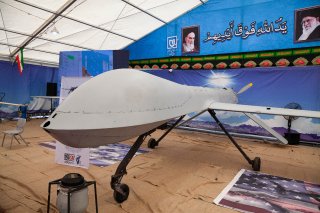Why Kataib Hezbollah Targeted U.S. Troops in Jordan
Last Sunday’s attack showed that the U.S.-Jordan relationship could be in the crosshairs of Iran’s proxy network.
On January 28, a drone strike conducted by the Iran-linked Kataib Hezbollah group killed three U.S. soldiers and injured more than forty others at a remote logistics base on the border of Syria, Iraq, and Jordan. The strike on Tower 22 in northeast Jordan caused the first known American military fatalities from hostile fire since the outbreak of the Israel-Hamas war back in October. Reports indicate that the strike was successful because air defenses identified the hostile drone as a U.S. drone that was returning to the base.
Tower 22 is a crucial supply hub for the American al-Tanf military base across the border in Syria and hosts an estimated 350 army and air force troops. Al-Tanf has been a key node in U.S. operations against the Islamic State (ISIS) and its efforts to contain Iranian influence in the region.
The Biden administration is reportedly preparing for strikes on multiple targets in retaliation to the attack, recognizing that statements made by Kataib Hezbollah, the Iran-backed Iraqi militia widely believed to be behind the attack, that it was suspending future attacks against U.S. forces and the head of Iran’s Revolutionary Guards called for de-escalation to avoid an all-out war are likely disingenuous. But it is still important to recognize that the Tower 22 strike was more than just an attack on the United States. It was also an attack on Jordan and not an isolated incident.
In December and January, Jordanian forces conducted several airstrikes and raids on targets identified as potential farms and hideouts of Iran-linked drug smugglers. The operation comes amid a surge in smuggling of drugs, weapons, and explosives in Jordan by what are thought to be Iran-linked smugglers. The uptick in these kinds of incidents shows that Tehran is hoping to make Jordan a transit point for weapon and drug smuggling—and, in the future, could even use the country as a launching point for attacks against Israel.
At the same time, Iran-linked militias in Iraq and Syria reportedly launched three drone strikes in November and December through Jordanian airspace en route to Israel. In October, the Houthis launched a cruise missile through Jordanian territory, which eventually crashed near the southern Jordanian town of Mudawwara, likely due to a technical malfunction or fuel depletion. The strikes threaten Jordanian civilians, violate the kingdom’s sovereignty, and put the government in a difficult position when it comes to the United States and Israel.
It’s clear that the Hashemite Kingdom’s close relationship with the United States and Israel has made it a prime target for these bad actors.
The United States and Jordan have enjoyed close relations for more than seventy years, making the Hashemite Kingdom one of the United States’ most reliable partners in the region. Since 1946, Washington has provided Amman with more than $17.3 billion in foreign aid. In January 2023, the two countries agreed to a $4.2 billion deal to give the Jordanian government with advanced Block 70 F-16 fighter jets, furthering a seven-year Memorandum of Understanding signed in 2022. Jordan hosts nearly 3,000 U.S. troops and serves as a valuable partner for American counterterrorism operations as well as a mediator between Israel and Palestine.
While Israel and Jordan first normalized relations back in 1994, their cooperation has gained momentum in recent years in an attempt to combat both Iranian influence in the region and the threat of ISIS. Their relationship has included intelligence sharing, security assistance, and, in some cases, even weapon transfers. For example, Israel sent sixteen decommissioned AH-1 Cobra helicopter gunships to Amman in 2015 to help bolster the kingdom’s capacity to fight ISIS and other insurgents from neighboring Iraq and Syria.
Shortly after the outbreak of the Israel-Hamas war in October, the Jordanian government requested that Washington deploy Patriot air defense systems inside the kingdom. While the Patriot, one of the most advanced U.S. air defense systems that costs $1.1 billion per unit, is often in short supply, the request isn’t unheard of. Patriot missiles were deployed in Jordan in 2013 amid concerns that the Syrian civil war could devolve into a regional conflict. Moreover, the United States deployed six additional Patriot systems to the Middle East in November, doubling their regional deployment.
While the kingdom’s request appears to have gone unfulfilled, reports indicate that Amman has renewed requests for advanced U.S. defense hardware, including the Patriot, after the Tower 22 attack. The deployment of such a system would do more than just protect Jordanian territory from strikes. It would also reassure a key U.S. ally at a time when it has heightened concerns about Iran’s malign actions and the Israel-Hamas conflict spiraling into a wider regional war.
Emily Milliken is the Senior Vice President and Lead Analyst at Askari Associates, LLC.
Image: Shutterstock.com.

